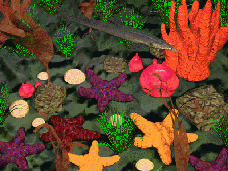
Oceans- Coral Reefs |


Grade Level:
2
Objectives:
The students will be
able to define what constitutes an ocean coral reef and the types of living things
found there. They will also
recognize and remember the rainforest and desert habitats.
Materials: coral reef habitat posters, National Geographic children's video *Deep Sea Dive, assorted art supplies (tissue, construction paper, tag board, tempera paint, pipe cleaners), glue, scissors and butcher paper for mural. Teachers can great excellent information on the coral reef at NOAA Coral Reef
*If
this video is not available, select a similar coral reef video.
Procedure: Review with students material covered in previous lessons.
Explain what a coral reef is.
Refer
to poster and show the students all the different types of living things found
in a coral reef.
Discuss
what constitutes a coral reef -
The world of the coral reef is one of the most diverse ecosystems on our planet, rivaling even that of the tropical rain forest
Built over thousands of years by tiny calcium-producing organisms, the reefs are a haven for countless thousands of life forms
Although various types of corals can be found from the water's surface to depths of 19,700 ft. (6,000 m), reef- building corals are generally found at depths of less than 150 ft (46 m)
Reef-building corals require warm ocean temperatures (68 to 82 F, or 20 to 28 C)
Review
with the students the definition of a habitat and what the characteristics of a
rainforest and desert are.
Show National
Geographic video.
Discuss with students what was seen in the video
Ask
students to give examples of some animal and plant populations found in coral reefs -
corals, sea anemones, sea pens, polyps, eels, rays, clown fish, sharks, sea
urchins, and sea pansies.
Activity:
Students will be given a variety of art
supplies such as pipe cleaners, construction paper, tissue scraps, tempera
paint, etc. In cooperative groups
they will each be asked to create pictures of animals and vegetation found in coral
reefs. Together, all of these projects will be used to make a class “coral
reef mural.”
Evaluation: Students will be evaluated on their coral reef mural using the Habitat Checklist.
Extension Activity: Favorite Coral Reef Animals
Students will conduct a survey of their favorite coral reef animal and create a graph from data
Examples of coral reef animals: sharks, rays, clown fish, angel fish, scorpion fish, eels, jaw fish, coral
Students open a blank spreadsheet
Enter
data
Highlight data and create a bar graph
Change
the color and size of the bars

Find clip art and pictures for each animal
Insert graphics
Proof read and print
Field Trip: Take a virtual field trip at CyberLearn. Click on the Reef zone sections to see each section of a coral reef. Take students to a local aquarium to see coral reef plants and animals.
Homework: Write a poem about a coral reef plant or animal; post on the Internet at The Kid Authors Web site.
Savage
Hyperactive
Aquatic
Roaming
King
Tip:
Have students use a dictionary and thesaurus to expand vocabulary.